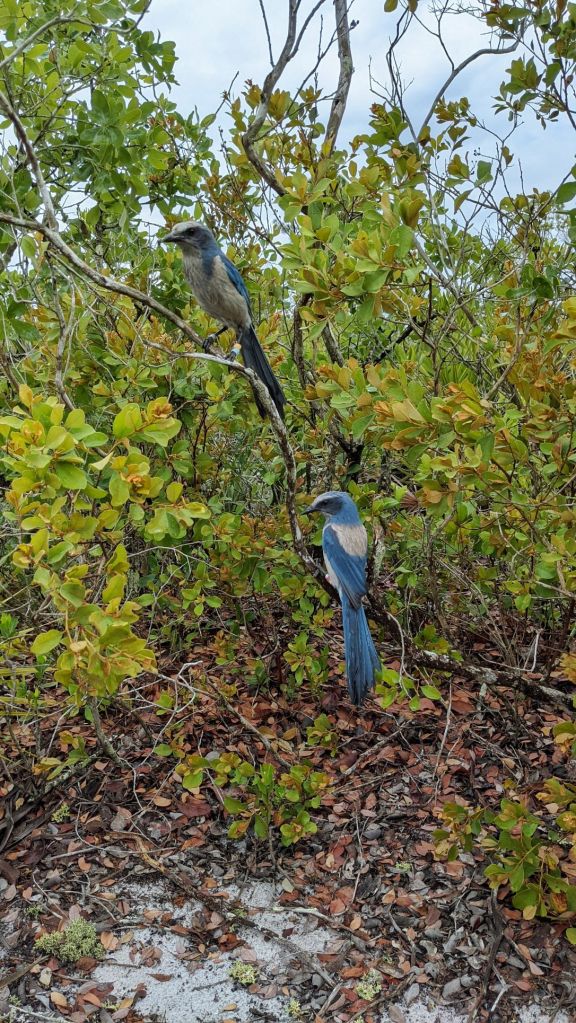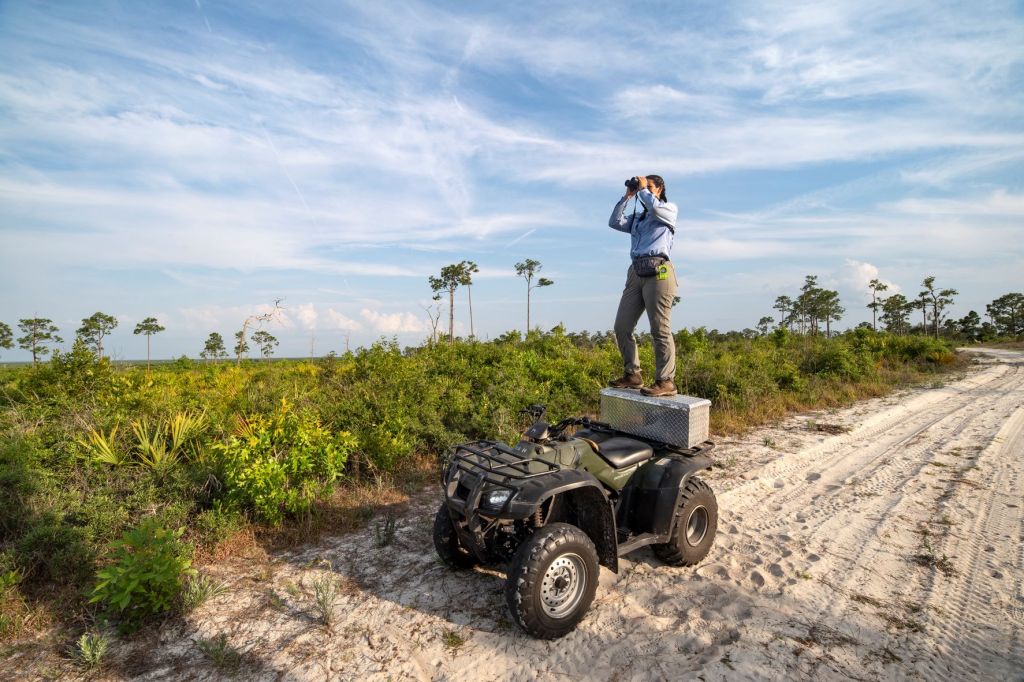
Authors: Meredith Heather and Reed Bowman
Peanuts are tossed in the air by Archbold scientists making a loud “schuuuup” call, one the Florida Scrub-Jays recognize as a dinner bell. The birds swoop down to the sandy lane to grab one while researchers record the individual color band combinations on each bird’s leg. As soon as the entire family group is seen, they move on to the next, until all the jays are either seen, or recorded as missing. Once a month, Archbold Biological Station’s Avian Ecology Program staff and interns census the entire population of Florida Scrub-Jays living within the ‘demography study tract,’ a study area that encompasses about 2/3 of Archbold’s scrub habitat.
Tori Bakley, a research assistant in the Avian Ecology program, said, “I enjoy census because I love visiting all of the jay families and collecting the inside scoop on what’s happening among them. If a jay is missing from the group, or a new bird has joined, we learn how family dynamics change over time.” Every researcher carries a printed hard copy of the census that lists each member of every different family group in the study area. Meredith Heather, a graduate student in the program, noted, “The call we make imitates a scold call that draws the attention of all nearby jays. The scrub-jays at Archbold are conditioned to come to the sound for a peanut reward. Archbold scientists only use peanuts occasionally, and only for research purposes, enabling science such as the monthly census. Peanuts are not offered as food items and are undesirable in comparison with natural food items like acorns.”
Scrub-Jays are highly territorial, and each territory and family group is given a four-letter name. Territories are often named after a local attribute (such as XRDS for a crossroad), someone in the Avian Ecology Program, or sometimes just something fun. Bryce Loschen, a post-baccalaureate intern in 2021, found the nest of a new breeding pair in an area of scrub dense with vines. That made it very difficult to access, so VINE seemed an especially appropriate name to describe the local habitat. Because scrub-jays mate for life, are long-lived, and their territories can be inherited by their offspring, some territory names have persisted for more than 40 years. New territories also form all the time: in 2021, there were eight new territories named.
How do Archbold scientists tell individual birds apart during the census? Each jay at Archbold is banded with a US Fish and Wildlife Service metal band with a unique identifying number, as well as two to three colored bands. The different colors, the order of the bands on the leg, and which leg the bands are on, help researchers identify individual birds by sight, and that combination serves as a unique ‘ID.’ For example, the birds in the photo are known as Q-YA and -HRQ, from the territory ROSE. The order of bands on the legs is specific to each year and can also be used to determine the age of a bird. However, the age of jays that immigrate into the Archbold population is often unknown, and these birds are given their own unique color band order to identify them as immigrants. Every 10-years, as color combination options run out, Archbold scientists have to re-use band combinations. A few jays can live as long as 14-15 years, so their combinations have to be retained and excluded from the re-issued combinations to avoid two birds with the same band combinations alive in the population at the same time.
Conducting a census of more than 200 individually banded birds in 75-85 family groups in a couple of days is no easy task and probably impossible for most bird species. It is possible with the jays because they are gregarious and social, they are trained to expect peanuts when they hear a specific call, and they arrive as a group to be observed. The habitat is open and the jays perch so that their leg bands are easily read. Yet even with these advantages, it takes 5-6 people two mornings to conduct a census, which over a year is a large investment of workforce. The census has been conducted monthly since 1971 without missing a single month. That is more than 600 monthly censuses spanning 50 years and nearly 16 generations of scrub-jays.
So why invest all this effort? Dr. Reed Bowman, the Director of the Avian Ecology Program explained, “The monthly census pulls all our jay data together. We find and monitor nests, we band birds, we map territories, but it all makes sense because we conduct censuses. From the censuses, we can determine survival rates for adults and juveniles, for breeders and non-breeders, for males and females. We can determine when young leave the home territory, at what age, where they settle, and with whom they mate. We can determine how jays respond to management or natural disturbances such as fire or storms. We begin to understand how populations fluctuate over time, including the factors that can lead to growth or declines. These insights inform management and increases the probability of conserving this threatened bird. Our long-term data, based on our censuses, is viewed as the gold standard for long-term studies throughout the world.” Dr. Bowman is the second generation of scientists leading the jay project at Archbold. The jay census data has been at the core of the incredible range of science published from this study over the years and will continue to be central to future science: Archbold plans for the census to continue for generations more of scientists as it has for generations of jays.

